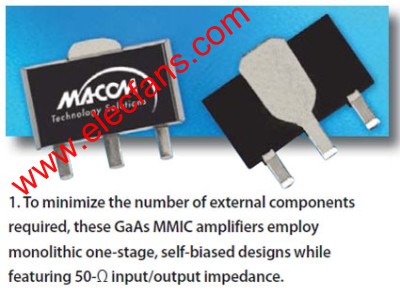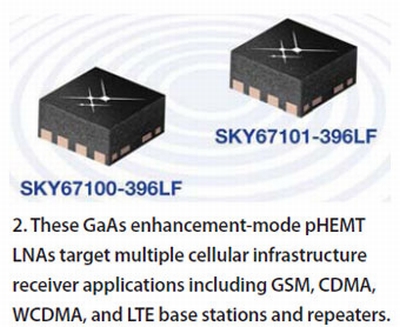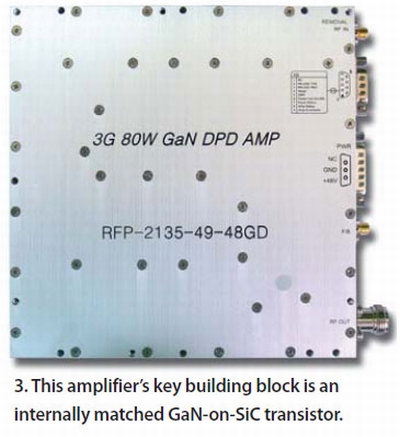The base station might be considered a fake technology ten years ago. But with the popularity of the "greening" project and the desire to reduce energy consumption to save costs, base station designers are looking for more integrated, more power-efficient, and smaller components. At the same time, in the next few years, mobile data traffic is expected to double every year. Therefore, it is necessary to reduce power consumption while increasing capacity. An amplifier is a key device that can reduce power consumption without affecting network capacity. Whether it is a low-noise amplifier (LNA), power amplifier (PA) or driver amplifier, their design is aimed at reducing the size, reducing power consumption, while achieving higher reliability and efficiency and greater capacity.
The demand for larger network capacity is increasing day by day. Fawad Maqbool, President of Amplitech, said, "Wireless applications and demand are constantly increasing. To meet the requirements of next-generation (4G, 5G) wireless products such as handheld PDAs and terrestrial communication links, more and more bandwidth is required. This demand is also Increasing the operating frequency and data rate steadily requires the receiving system to provide lower noise, lower distortion, higher dynamic range and wider coverage. "
There are many amplifiers that are constantly meeting these needs. For example, RFMD has just introduced a variable gain amplifier (DVGA) with high linearity and digital control (6b). The RFDA DVGA series provides noise specifications below 5dB over the entire gain range. Each VGA has a gain range of 31.5dB at 0.5dB step resolution. The series offers a variety of models that can support the following highest indicators: gain 38dB, output third-order intercept point (IP3) 43dBm, operating frequency 4GHz. For example, the RDA1005L covers the 10-4000MHz frequency band and provides a gain of 18.5dB at 0.5dB steps. Its 1dB compression point (P1dB) output power is 21.0dBm and output IP3 is 35.0dBm. The same series of products RFDA2026 covers the 1800 ~ 2400MHz frequency band, the gain is 32.0dB in 0.5dB step. Its 1dB compression point output power is 24.0dBm, and the output IP3 is 43.0dBm. These devices are suitable for receiver and transmitter design, and provide both parallel and serial interface versions.
The wireless infrastructure is also a target application for RFMD RF5633 (2.2-3.8GHz) WiMAX power amplifier ICs. This IC uses indium gallium phosphide (InGaP) heterojunction bipolar transistor (HBT) technology and integrates a three-stage PA and power detector. It provides an error vector magnitude (EVM) of 2.5%, and the output power in the 3.4-3.6 GHz and 3.6-3.8 GHz bands is +28 dBm and +27 dBm, respectively. The bias of the PA can be controlled to adapt to the 22dB gain step, thereby improving the system dynamic range. RF5633 provides 34dB gain.
A new 0.5W HBT amplifier from M / A-COM Technology SoluTIons is mainly aimed at cellular and WiMAX base station applications. MAAM-009286 covers the frequency band of 250 ~ 4000MHz, and its output IP3 is 42dBm under the bias of 5V / 155mA. Provides 15.5dB IF gain at 2140MHz. In addition, the company's 70-3000MHz series miniature gain stage amplifiers are suitable for cellular base stations.
These gallium arsenide (GaAs) monolithic microwave integrated circuit (MMIC) amplifiers use a single-stage, self-biased design (Figure 1). They have 50Ω input / output impedance to minimize the number of external components required. The MAAL-009120 of M / A-COM has a typical noise of 1.4dB@900MHz. In the frequency band of 500 ~ 3000MHz, the IP3 is 35dBm. The products of the same series, MAAL-010200, have a typical noise of 1.3dB@900MHz. In the frequency band of 500 ~ 3000MHz, the IP3 is 36dBm. Both products have a typical gain of 14dB at 900MHz. Jack Redus, product manager at M / A–COM, said, “Faster data rates and more complex modulation schemes have prompted wireless infrastructure to require higher linearity for driver amplifiers. These trends are accompanied by a reduction in overall power consumption and manufacturing. The constant pursuit of complexity. Although integrating amplifiers, switches, attenuators, and other functions on a single chip can simplify the manufacturing process, it often sacrifices the performance of each functional block. Multi-function of different technologies in a single package Integration can optimize performance and manufacturing, and ultimately replace single-function devices. Some of the single-function amplifiers we currently offer will be integrated into multi-function, multi-chip solutions using surface mount in the future. "

Figure 1: To minimize the number of external components, these GaAs MMIC amplifiers use a single-stage, self-biased design.
WiMax and 4G LTE applications (2.3-2.8GHz) are also targeted applications of GaAs InGaP HBT MMIC power amplifiers launched by HitTIte Microwave. The PA of this model HMC755LP4E has a gain of 31dB when the output IP3 is 43dBm. 28% power added efficiency (PAE) can be achieved at 33dBm saturated output power. Three power control pins can be used to reduce the RF output power or turn off the PA to save DC power consumption. Using orthogonal frequency division multiplexing (OFDM) signals, the HMC755LP4E can achieve an output power of 25dBm (64QAM, 54Mb / s), while the EVM is 2.5%.
Although Freescale is known for its LDMOS technology, the company recently introduced MMIC products optimized for the functional requirements of transmitters and receivers in base stations, home base stations, and cellular repeaters. This group of devices meets the requirements of both low-noise amplifiers and transmit power amplifiers. For example, MML09211H is an enhanced pHEMT MMIC low-noise amplifier, which is very suitable for various applications such as WCDMA base stations in the 865-960MHz frequency band and the high-data-rate network in the 728-768MHz frequency band currently being implemented. In the 400 ~ 1400MHz frequency band, the device has a low noise index of 0.6dB. At 900MHz, the small signal gain is 20dB, and the P1dB output power is 21dBm. This amplifier has 35dBm isolation performance and 32dBm output IP3. The same series of products MMA20312B is a two-stage InGaP HBT power amplifier designed for wireless base stations as well as repeaters and home base stations. The amplifier covers the frequency band from 1800 to 2200MHz. The small signal gain at 2140MHz is 26dB, and the P1dB output power is 31dBm.
The other two newest broadband MMIC amplifiers are both suitable for driving amplifiers in the transmission chain and can be used as secondary low-noise amplifiers in the receiving chain. The MMG15241H pHEMT device covers the frequency band from 500 to 2800MHz, and the noise figure at 2140MHz is 1.6dB. P1dB output power is + 24dBm, IP3 is 39dBm, and small signal gain is 15dB. In addition, the MMG20271H low noise amplifier covers the frequency range of 1500 to 2400MHz. It has a noise figure of 1.8dB at 2140MHz, a P1dB output power of + 27dBm, an IP3 of 42dBm and a small signal gain of 15dB.
Skyworks SoluTIons' two new GaAs MMIC low-noise amplifiers claim to meet the demanding noise and linearity requirements of multiple cellular infrastructure receiver applications (including GSM, CDMA, WCDMA and LTE base stations and repeaters) (Figure 2). SKY67100-396LF covers 1.7 ~ 2.0GHz frequency band, SKY67101-396LF covers 0.7 ~ 1.0GHz frequency band. These enhanced pseudomorphic high electron mobility transistor (pHEMT) low noise amplifiers have a low noise figure of 0.49dB and an output third-order intercept point of 34dBm. Its internal active bias circuit ensures stable performance at different temperatures.

Figure 2: These two GaAs enhanced pHEMT low-noise amplifiers are mainly aimed at a variety of cellular infrastructure receiver applications (including GSM, CDMA, WCDMA and LTE base stations and repeaters).
At 1.95GHz, the noise figure of SKY67100-396LF is 0.61dB. It has an input return loss better than 20dB and a high-output third-order intercept point of 34dBm. At 0.9GHz, the noise figure of SKY67101-396LF is 0.49dB. Its input and output return loss at 0.9GHz is above 20dB. At 0.9GHz, this LNA has a high third-order intercept point of 34.1dBm.
Avago Technologies' two devices covering the 1500 to 2300MHz and 2300 to 4000MHz bands, respectively, complete the company's next-generation low-noise amplifier series, which covers all cellular frequency bands for GSM, CDMA, UMTS, WiMAX, and LTE. These LNAs are developed for base station RF front-end design. Under typical operating conditions of 1900MHz and 5V / 51mA, the company's patented GaAs enhanced pHEMT process technology provides a noise figure of 0.48dB and OIP3 of 35dBm. It has a gain of 17.8dB and a P1dB output power of 21dBm. Under typical operating conditions of 2500MHz and 5V / 56mA, the technology provides a noise figure of 0.59dB and OIP3 of 35dBm. It has a gain of 17.5dB and a P1dB compression point output power of + 22dBm. Thanks to the built-in active bias circuit, the operating current of the Avago low-noise amplifier is adjustable. Therefore, designers can trade off between operating current and output linearity (measured with OIP3) while maintaining the best noise figure.
Aeroflex / Metelics' HBT amplifier product line is ideal for cellular, PCS, 2.5 / 3G, MMDS, WLL and other wireless infrastructure applications. The company also provides medium / small power amplifiers and Darlington gain modules. The HBT medium / small power amplifier is designed for high-frequency, Class A drive devices, with an output power of 0.25 to 4W and a gain range of 100MHz to 2650MHz. For example, MMA717-3030 is designed for medium power levels from 100MHz to 2.5GHz. Under normal circumstances, it has an output power of 31dBm, high output IP3 of 50dBm, and its typical dynamic range is 97dB.
For Aeroflex / Metelics, InGaP HBT MMIC amplifiers are specifically designed as broadband Darlington gain modules, which combine different levels of small signal gain, noise and bandwidth. They can provide a flat gain response from 100MHz to 12GHz. For example, at 2GHz, MMA708 covers DC ~ 4000MHz, while providing 13dB of gain. Its output power at -1dB is 20dBm, and the typical IP3 is 38dBm. The amplifier provides a 6dB noise figure, and its input and output VSWR (voltage standing wave ratio) are 1.40: 1 and 2.00: 1, respectively.
At the previous IEEE International Microwave Symposium (IMS), NXP Semiconductors (NXP) demonstrated a series of RF and IF amplifiers based on silicon-germanium-carbon (SiGe: C) technology, ranging from low-noise amplifiers to fixed and variable A series of products such as gain amplifiers, these devices are said to achieve higher integration in the RF design of transceivers in wireless infrastructure. The company provides a series of Doherty amplifiers covering 400 ~ 3500MHz, including a three-way Doherty amplifier and a single package 600W Doherty amplifier based on the company's 50V LDMOS process, they all work at 900MHz. This three-way Doherty power amplifier can achieve a peak power of 52.7 dBm (average power of 44.1 dBm) with an efficiency of up to 49.2%. The 600W (57.8dBm) single package circuit can achieve an efficiency of more than 43%, and has an output power of 49.2dBm in the entire operating band.
RFHIC stated that it is a challenge for LDMOS to achieve higher efficiency over the entire 30MHz bandwidth and six channels. In addition, the LDMOS transistor package and input / output matching pattern will be larger. Therefore, the company chose the gallium nitride (GaN) method. The 80W power amplifier for LTE and WCDMA applications covers 2110-2140MHz and the bandwidth is 30MHz (Figure 3). With Doherty design and DPD technology, it can provide 35% or higher efficiency. The power amplifier has a gain of 50dB at 48V. Through cooperation with South Korean mobile service provider SK Telecom, this gallium nitride (GaN) amplifier has been deployed at selected locations. The goal of RFHIC's next-generation products is to achieve 40% efficiency.

Figure 3: The key building block of this amplifier is an internally matched GaN-on-SiC transistor.
In addition to amplifiers, companies like Nujira also provide supporting products and services to support the evaluation and development of base stations and remote radio head power amplifiers. For example, the NCT-E9001 evaluation and development platform package includes waveform transmission and analysis, multi-mode digital predistortion (DPD), and a complete RF transmission link. The EvalSys toolkit provides control and analysis tools. For parameter comparison and development, users can integrate their own PA design, DPD algorithm and DPD hardware. So far, the reference PA output stage can provide 28V and 48V RF power transistors based on LDMOS and GaN. Of course, products of other specifications are also under development. The company also offers Coolteq-h high-power modulators, which can increase the efficiency of power amplifiers to 60%.
AmpliTech has taken another interesting approach. The company provides a series of low-temperature amplifiers and systems. These products promise to greatly improve all the parameters and coverage of wireless systems, while meeting the harshness of future wireless technologies on base stations and multi-point links. demand. For example, the company's 80 ° K low-temperature cooling LNA components provide noise figures as low as 0.05dB in the GPS and GSM bands, and 0.6dB in the Ka band. This cooled low noise amplifier / component is placed directly on the antenna feed through a 3m umbilical cord. Because there are no noise sidebands, it simplifies digital signal processing (DSP) post-processing.
Transistor development technology helps improve the efficiency of base station amplifiers. For example, TriQuint's TriPower GaAs HV-HBT RF IC promises to support operators to more easily increase network capacity and speed while reducing the power required by network base station amplifiers. Currently, to cover a medium-sized city and surrounding areas, a system with 2000 amplifiers may be needed. According to TriQuint, the TriPower-based network will reduce carbon dioxide emissions by approximately 340 tons per year.
When used for symmetrical Doherty amplifier applications for maximum efficiency, the two TriQuint TG2H214120 120W devices can provide WCDMA average power over 60W with an efficiency of 55%. Because TriPower's efficiency is very high, operators can install larger amplifiers on existing base station towers without adding size and weight, and high power amplifiers can provide higher data transmission rates for all users in the cell. Obviously, the amplifier is the key to energy saving of the base station. But there are a series of related technologies that can help the amplifier meet the demand for higher performance and lower power consumption.
The installation of the tunnel wall and wall-mounted installation of the same, there is no special place, and this wall-mounted tunnel lights can be installed on a wide range of tunnel space, installation methods are very simple, embedded circuit , The installation of the tunnel lights, then the lamp on the fixed, of course, which also need to install an electrical box, to provide power for the lamps.
Wall Hanging LED Tunnel Light,150W Wall Hanging LED Tunnel Light,Waterproof Wall Hanging LED Tunnel Light,Wall Mounting Outdoor LED Tunnel Light
Shenzhen Ri Yue Guang Hua Technology Co., Ltd. , https://www.ledlightinside.com